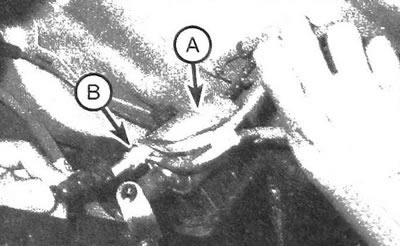Warning: When performing routine inspection and maintenance of fuel system components, certain precautions must be observed. Work in well-ventilated areas, and do not allow open flames or light bulbs without a protective hood in the work area. Do not allow gasoline to come into contact with your skin. Wear rubber gloves. If gasoline gets on your skin, wash it off with running water and soap. Immediately wipe up any spilled fuel and store any material that has absorbed it in a place where there is no risk of fire. Before exposing elements, relieve pressure in the system (see chapter 4). Have a Class B fire extinguisher on hand and operate the system with special eye protection.
1. Relieve pressure in the fuel system (chapter 4). Disconnect the negative cable from the battery.
2. Raise the vehicle and support it with vertical supports.
3. The fuel filter is located in a bracket on the fuel tank.
4. Using compressed air or a fuel system cleaner, remove dirt from the areas adjacent to the filter inlet and outlet channels.
5. At each end of the filter there is a quick-release coupling, to disconnect which you need to use needle-nose pliers or squeeze the clamp with your fingers (see illustration).

24.5. When replacing the fuel filter (A), To disconnect the couplings, you need to squeeze the clamps (IN)
Note: To receive or absorb the fuel in the filter, you must place a suitable container or use a wet cloth.
6. Unscrew the screw securing the bracket to the tank.
Note: On four-wheel drive vehicles, the tank has a protective panel that has a hole for access to the bracket screw.
7. Squeeze the plastic clips and disconnect the fuel lines from the filter. New filter modifications have improved clamps.
8. Installation is carried out in the reverse order of removal.
